#Chandra
Text

Astronomers used three of NASA's Great Observatories to capture this multiwavelength image showing galaxy cluster IDCS J1426.5+3508. It includes X-rays recorded by the Chandra X-ray Observatory in blue, visible light observed by the Hubble Space Telescope in green, and infrared light from the Spitzer Space Telescope in red. This rare galaxy cluster has important implications for understanding how these megastructures formed and evolved early in the universe.
How Astronomers Time Travel
Let’s add another item to your travel bucket list: the early universe! You don’t need the type of time machine you see in sci-fi movies, and you don’t have to worry about getting trapped in the past. You don’t even need to leave the comfort of your home! All you need is a powerful space-based telescope.
But let’s start small and work our way up to the farthest reaches of space. We’ll explain how it all works along the way.

This animation illustrates how fast light travels between Earth and the Moon. The farther light has to travel, the more noticeable its speed limit becomes.
The speed of light is superfast, but it isn’t infinite. It travels at about 186,000 miles (300 million meters) per second. That means that it takes time for the light from any object to reach our eyes. The farther it is, the more time it takes.
You can see nearby things basically in real time because the light travel time isn’t long enough to make a difference. Even if an object is 100 miles (161 kilometers) away, it takes just 0.0005 seconds for light to travel that far. But on astronomical scales, the effects become noticeable.
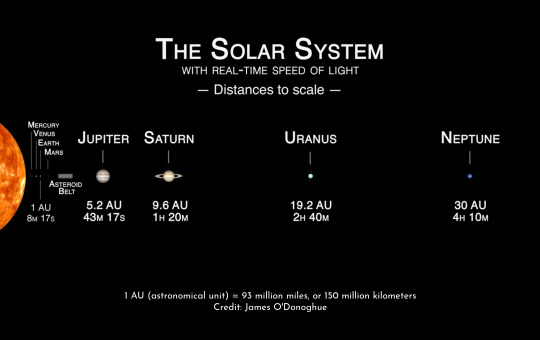
This infographic shows how long it takes light to travel to different planets in our solar system.
Within our solar system, light’s speed limit means it can take a while to communicate back and forth between spacecraft and ground stations on Earth. We see the Moon, Sun, and planets as they were slightly in the past, but it's not usually far enough back to be scientifically interesting.
As we peer farther out into our galaxy, we use light-years to talk about distances. Smaller units like miles or kilometers would be too overwhelming and we’d lose a sense of their meaning. One light-year – the distance light travels in a year – is nearly 6 trillion miles (9.5 trillion kilometers). And that’s just a tiny baby step into the cosmos.
youtube
The Sun’s closest neighboring star, Proxima Centauri, is 4.2 light-years away. That means we see it as it was about four years ago. Betelgeuse, a more distant (and more volatile) stellar neighbor, is around 700 light-years away. Because of light’s lag time, astronomers don’t know for sure whether this supergiant star is still there! It may have already blasted itself apart in a supernova explosion – but it probably has another 10,000 years or more to go.
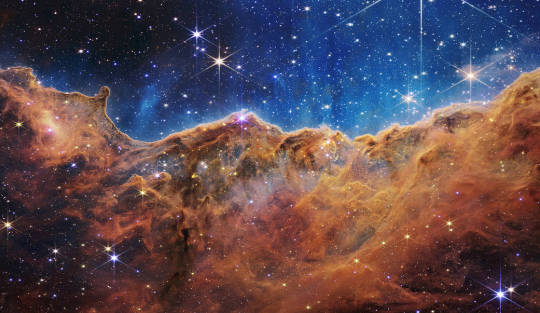
What looks much like craggy mountains on a moonlit evening is actually the edge of a nearby, young, star-forming region NGC 3324 in the Carina Nebula. Captured in infrared light by the Near-Infrared Camera (NIRCam) on NASA’s James Webb Space Telescope, this image reveals previously obscured areas of star birth.
The Carina Nebula clocks in at 7,500 light-years away, which means the light we receive from it today began its journey about 3,000 years before the pyramids of Giza in Egypt were built! Many new stars there have undoubtedly been born by now, but their light may not reach Earth for thousands of years.
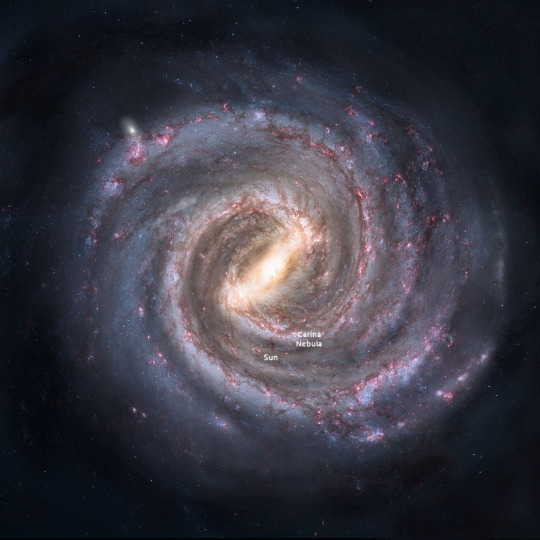
An artist’s concept of our Milky Way galaxy, with rough locations for the Sun and Carina nebula marked.
If we zoom way out, you can see that 7,500 light-years away is still pretty much within our neighborhood. Let’s look further back in time…

This stunning image by the NASA/ESA Hubble Space Telescope features the spiral galaxy NGC 5643. Looking this good isn’t easy; 30 different exposures, for a total of nine hours of observation time, together with Hubble’s high resolution and clarity, were needed to produce an image of such exquisite detail and beauty.
Peering outside our Milky Way galaxy transports us much further into the past. The Andromeda galaxy, our nearest large galactic neighbor, is about 2.5 million light-years away. And that’s still pretty close, as far as the universe goes. The image above shows the spiral galaxy NGC 5643, which is about 60 million light-years away! That means we see it as it was about 60 million years ago.
As telescopes look deeper into the universe, they capture snapshots in time from different cosmic eras. Astronomers can stitch those snapshots together to unravel things like galaxy evolution. The closest ones are more mature; we see them nearly as they truly are in the present day because their light doesn’t have to travel as far to reach us. We can’t rewind those galaxies (or our own), but we can get clues about how they likely developed. Looking at galaxies that are farther and farther away means seeing these star cities in ever earlier stages of development.
youtube
The farthest galaxies we can see are both old and young. They’re billions of years old now, and the light we receive from them is ancient since it took so long to traverse the cosmos. But since their light was emitted when the galaxies were young, it gives us a view of their infancy.

This animation is an artist’s concept of the big bang, with representations of the early universe and its expansion.
Comparing how fast objects at different distances are moving away opened up the biggest mystery in modern astronomy: cosmic acceleration. The universe was already expanding as a result of the big bang, but astronomers expected it to slow down over time. Instead, it’s speeding up!
The universe’s expansion makes it tricky to talk about the distances of the farthest objects. We often use lookback time, which is the amount of time it took for an object’s light to reach us. That’s simpler than using a literal distance, because an object that was 10 billion light-years away when it emitted the light we received from it would actually be more than 16 billion light-years away right now, due to the expansion of space. We can even see objects that are presently over 30 billion light-years from Earth, even though the universe is only about 14 billion years old.

This James Webb Space Telescope image shines with the light from galaxies that are more than 13.4 billion years old, dating back to less than 400 million years after the big bang.
Our James Webb Space Telescope has helped us time travel back more than 13.4 billion years, to when the universe was less than 400 million years old. When our Nancy Grace Roman Space Telescope launches in a few years, astronomers will pair its vast view of space with Webb’s zooming capabilities to study the early universe in better ways than ever before. And don’t worry – these telescopes will make plenty of pit stops along the way at other exciting cosmic destinations across space and time.
Learn more about the exciting science Roman will investigate on X and Facebook.
Make sure to follow us on Tumblr for your regular dose of space!
#NASA#astronomy#telescope#Roman Space Telescope#dark energy#galaxies#cosmology#astrophysics#stars#galaxy#Hubble#Webb#Chandra#Spitzer#space images#Youtube
3K notes
·
View notes
Text

leaf head!!
475 notes
·
View notes
Text
Meow-gic: The Gathering

#magic: the gathering#mtg#Chandra#red mana#burn deck#cat cosplay#cosplay#cats#kitty#cats in costumes#cat#cats of tumblr#aww#cat costume#fan art
383 notes
·
View notes
Text

Chandra by Santi Bosch
#Magic the Gathering#MtG#Kaladesh#Chandra#Chandra Nalaar#Fan Art#Fantasy#Art#Santi Bosch#Wizards of the Coast
207 notes
·
View notes
Text
the femininity of shani (what we can learn from pushya) 🌷

🌷 monica bellucci: pushya chandra
🌫️ The mystical tundra of Shani is often overlooked by its restricting feminine complexity and misconstrued for the nature of Buddha (the tantalizing serpent of Ashlesha). While their indirect submissive natures are similar in comparison, it is often natives of Mercury who use this explicit behavioral pattern for more materialistic, perhaps conniving, matters at hand. In this exploration of Shani’s ancient connection to divine femininity, I want to purposefully disclose that their submissive, seemingly “neutral” expressions are not the same. Buddha is the snake of binding to the collective for the intent of freedom and entangling or ensnaring their victim for the purpose of disempowering. Shani is the snake of binding to the contemporary nature of society for the intent of cooling the darkness of ego and empowering the higher collective. Buddha bestows the intelligence of the material aspects of the subversion into the intellect of worldly matters. However, Shani is the intelligence of the occult undertones which control the very essence of the material plane and the union of what is to come after we conquer the very shadows of the tenth house (the rashi of capricorn who will be the awakening of the realm, once we are released from Kali Yuga) to the hidden truths of the eleventh house, the supposed house of personal ties and fulfillment.

🌷 jessica lange: pushya lagna
☔️ There is a specific air of mystery around Shani and the graha’s corresponding nakshatras, bhavas and rashis. Much of the information provided is rather repetitively regurgitated from varying sources and of surface nature. My goal with this exploration is not to specifically delve in the expressional aspects of Shani, but to focus on the graha’s distinct involvement in the path of divine femininity. My hope is this exploration will awaken the serpent of knowledge within you, to explore the more niche archetypes within the vata umbrella that is Saturn.

🌷 miranda kerr: pushya lagna
⛩️ Vata dosha is most synonymous with cold, bereaved individuals who search this earthly plane longing for sustenance. It is the cold hands that seek to grasp the tangibility of spiritual words, it is the homeless widow who was once filled with wanderlust now bereaved, it is the drowsy feeling that surmounts when you look upon the rain beating down on your window pane. It is the dosha characteristic of the feelings we most disdain and wish to shy away from and simultaneously the realm of Shani, Chandra, and Rahu. We have heard the tales of the greedy, insatiable spirit of Rahu; the forgetful, lusting of Chandra; and the forever dried and cold spirit of Shani. Having repeatedly heard the rhetoric of these respective deities, a certain air of weariness has surrounded them respectfully. But you must continue to remind yourself of the necessity of attaining equilibrium and leaning into each graha’s meanings, teachings, and significances. If you are dominant in either of these vata grahas, know that you are more than the sterile or greedy archetype that has been placed upon you, as Kali (Shani) was equally as ferocious as she was creationist, Chhinnamasta (Rahu) was equally as violent as she was self-sacrificing, and Bhuvaneshvari (Chandra) is equally as intimidating as she is the supreme being of the earth, atmosphere, and heavens.

🌷 paris hilton: pushya chandra
🩸 In a similar fashion, the ethereal air of vata is equally as destructive as it is light, cool and dry. It governs all movement and processes in your mind and body (such as blood flow, breathing, and the coagulation of thoughts in your mind). This rulership of movement is why Shani is so astute and articulate within the realm of femininity. Shani is able to manipulate the vata element to attract and constrict around those we long to unite with. These elements of constriction are often associated with Ashlesha/Buddha, but significantly vary from each other.

🌷 gisele bundchen: pushya surya
🐍 Think of the Pushya nakshatra, the “Kula” star, resembling the flower of the snake gourd. Similar to Ashlesha, Pushya is also associated with serpentine movement. It is the maternal snake before it enters the stage of selfishness. It is focused on laying its cosmological eggs, whereas Ashlesha is the mother after this stage that abandons the cosmic eggs of Brihaspati (carefully crafted in Punarvasu) to never return or protect her young again. Ashlesha is leering into the gandanta knot spirituality of disempowering the collective, coiling up to rest in preparation for the spiritual shedding that awaits in Magha. Pushya is leering into the birthing of the collective itself. With the knowledge of vata dosha, Pushya is able to tap into previous experiences of destruction and coldness to relate to others. Using those previous experiences to further divulge into the mystified unknown that often longs to be hidden.

🌷 kate moss: pushya lagna
💒 This is why the cancer rashi is essential for developing cosmic energy and harnessing/wielding it. The cancer rashi is ruled by Chandra, of which is correlated to the Kamala Mahavidya (the vata being whose symbolism is comparable to that of Aphrodite or the Christian Mary). The primary “devastating” nature of vata is what sprouts fertility and purity, as the dirtiest mud will produce the freshest lotus. It is recommended in order to celebrate her, devotees engage in eating spicy, hot foods, as they ignite passion. These spices may include cinnamon, garlic, saffron, or chili peppers due to heavily spiced foods having the ability to bear this Mahavidya’s luscious energy. These same foods are associated with the vata Shani, in a similar fashion, Shani and Chandra are considered enemies but respectfully hold the cosmic keys to one another through the likes of Pushya and Shravana. The metaphor for the consumption of extreme vata spices that one earns the ability to celebrate and veneer the Mahavidya in her idealistic form is comparable to the narrative of sacrifice one must engage in to witness beauty (spiritually and physically). Aphrodite was offered sacrificial doves (bird’s being Shani’s primary vahana: vehicle) and smoky incense (smoke being ether in nature which is of vata dosha) in an attempt to receive love, fertility, and union. Whereas, the Virgin Mary was deemed pure due to her great sacrifice when she offered up the life of her Divine Son Jesus using her “Immaculate Heart” (similar to Kamala’s abundance in the anahata/heart chakra). In “A Prayer of Praise to the Blessed Virgin Mary” by St. Ephrem, he sang: “….Thou indeed art our only hope, most sure and sacred in God's sight, to whom be honor and glory, majesty and dominion, for ever and ever, world without end. Amen.”. Similar to Kamala, Aphrodite, and the Virgin Mary, so too must the masses work to earn the right to witness Shani’s femininity due to its premiere selectivity. This is why Pushya births the highest grossing models and revolutionary actresses in history [e.g. Halle Berry, Twiggy, Marlene Dietrich, Selena Gomez (who is now the most followed woman on Instagram) etc.], as the masses find pleasure in working to witness the mysticism vata bestows.

🌷 selena gomez: pushya surya and lagna
🍷 This mysticism is often deemed “odd”, “exotic” or “unique” and this is exactly where we can learn from the Mahavidya Kali. The darkened Mahavidya Kali breaks conventional stereotypes of feminine beauty and sexuality in Hindu goddess mythology. She serves as the dominant sexual partner straddling the prone Shiva (the master of poison and medicine, the great yogi, overlord of time, the cosmic dancer) and the wild warrior goddess drinking demon blood. She is originally depicted as a symbol of uncontrolled fury emerging from the fair, beautiful goddess Ambika (goddess of supreme power, energy and invincibility), in the battle with the demons in older Vedic texts. Thereafter, she gains independent existence both as the dark, mysterious and sexually demanding version of the more benign and auspicious Parvati and the primordial goddess power pre-dating the Hindu trinity of male gods, the Universal Mother Force which embraces both good and evil, gods and demons in the Kalika Purana. Unlike other texts which emphasize Kali's role in the battle against the demons, the Kalika Purana's focus is on her sexuality and her darkly sensual beauty. Equally it is on the heterodoxical rituals associated with her worship involving blood and flesh offerings, wine and the use of sexual intercourse as opposed to Vedic rituals.

🌷 dakota fanning: pushya chandra
❤️🔥 In Kalika Purana, Daksha’s daughter Sati, born fair, assumes the fearful visage of Kali and the other Mahavidyas to terrify Shiva into submission. At Daksha’s yagna, her father attributes her dark color to constant proximity to the wild-mendicant Shiva, causing her to give up her life in sorrow and humiliation. In the second portion of the Purana, she takes the dark and beautiful form of Parvati, similar to the appearance of a blue lotus. She was born to serve the gods’ purpose of luring into domesticity the stern, austere hermit-like Shiva to preserve the cosmic cycles of creation, preservation and destruction. It is only later, piqued and jealous of Shiva’s propensity towards fair-skinned goddesses that she emerges from her kosa (sheath) of darkness to become the golden-hued Gauri. Yet her darkly alluring and compelling sexuality is highlighted in the text as opposed to the prototype of a domesticated wife and mother like Candi in the Candi Mangal Kavya. John Stratton Hawley in his Prologue to “Devi: Goddesses of India”, noted that Kali in a strange way mediates between the transcendent goddess, the generic Devi who has supremacy over all forms of life and the consort goddesses like Lakshmi and Radha. Hawley wrote: “On the one hand, Kali unquestionably manifests herself as supreme—whether as a mother demanding submission or as an uncanny, uncontrollable force—but on the other hand, her supremacy is paradigmatically measured by the power she exerts over her consort the great god Shiva”. He detailed an example of her sexual dominance, the iconic representation of Kali dancing wildly on the prone, ithyphallic corpse of her husband Shiva. The Kalika Purana initially projects her as the manifestation of the universality of divine femininity, Mahamaya, who is Visnumaya and Rudrani consort of both Visnu and Rudra (Shiva). She is Savitri, Saraswati, through the power of her maya (illusion), incomprehensible to all who are ensnared in her power of illusion. She is Visnu’s Yoganidra, his state of cosmic sleep or stasis. She is Yogamaya/Mahamaya, who ensnares the cosmos in her web of illusion, she is Mahamoha, the fatal enchantress and the Supreme Trinity itself is not immune to her mysterious lure. Another goddess text, the Sri Lalita Sahasranama calls her Mahabhoga and Bhogini implying her rajasik-rupa (dynamism, also material grandeur) of being steeped in worldly luxuries. Yet she is the path to mukti (salvation) for beings trapped in the worldly and materialistic which is all part of her cosmic illusion. The Sri Lalita Sahasranama also states that she is Mohanasini, destroying the moha (bondage) of her devotees and Pasu-pasa-vimocini, releasing them from the inferior, coarser earthly bonds. She is Vidya (knowledge) for the householder who desires mukti (salvation), and Avidya (ignorance) who binds the universe in bonds of material desire. She is the primeval Demi-Urge, the Adyasakti that activates the inert maleness of Shiva into the dynamism of the Shiva-Sakti or Purusa-Prakrti union for without Sakti, Shiva is but a sava (corpse). Among the Sakta devotees it is Kali amongst the many manifestations of the divine feminine who is recognized as the Adya-murti, the original goddess manifestation. In the text, Kali alone can awaken the virility within Shiva, for on the one hand, she is a yogin to participate in his yoga and on the other, it is her eroticism, wild and uncontrolled, which is the perfect counterpart to his dominant sexual urges.

🌷 marlene dietrich: pushya chandra
🦶 Kali is feared in Hindu mythology as the negative stereotype in goddess cults and paradoxically revered as the Universal Mother. In a similar fashion, Pushya natives serve as the nourishing udder they are symbolized as, flowing with the golden knowledge of Brihaspati; yet their propensity for awakening occult knowledge and powers within their partners is hidden within the little knowledge the public has on this nakshatra. Kali’s iconic delineation, girded and garlanded with skulls and limbs while her hand is raised in the abhayamudra (gesture of reassurance from fear) indicates both chastisement and benediction. As a dark, complex, mysterious and alluring figure, she breaks conventional stereotypes of feminine beauty and sexuality, combining the beautiful with the fearful. Thus, explaining Pushya’s propensity for both embodying and challenging feminine stereotypes in the media (such as Paris Hilton’s hyperfemininity, Marlene Dietrich’s well-known portrayal for characters challenging the submissive standard of the 1900s, Halle Berry’s intimidatingly complex “Storm” character). In a traditionally patriarchal society and an androcentric religious order, Kali emerges as a rebel; dominant in marital and sexual relationships, ferocious, and bloodthirsty on the battlefield. Existing on the fringes of the dharmic value system and Vedic ritualism, the Kali-centric myths teeter dangerously on the extreme peripheries of social and moral acceptability in the iconic projection of her black nudity, voluptuous breasts, bloodstained, her foot on the prostrated corpse-like body of her consort Shive, and the sacrificial blood and flesh rituals associated with her worship.

🌷 angelina jolie: pushya lagna (note her films are wonderful examples of the nature of Pushya, from her Maleficent character’s sheep-like creature (the yoni of Pushya) to her dominatrix role, symbolizing the dark sexual subcultures of Shani in B*SM)
🍒 Kali conveys maya as seen from the “other shore”. She illustrates what the world of appearance looks like to the one who has seen beyond her overall presence (which is described as frightening) and her dwelling place lying within the cremation ground mocks the ultimate significance of a world grounded in the ego. In her “mad dancing, dishevelled hair and eerie howl, there is made present the hint of a world reeling, careening, out of control”. In conclusion, Kali, in integrating absolute binaries of the terrifying and the beautiful, the compassionate Mother and the blood-thirsty demon destroyer, the consort of Shiva and the sexually dominant partner draws a more comprehensive image of non-duality that is beyond the reductivist social and religious definitions of what is acceptable or what is heterodox. So too Pushyas embody life as it is in all its wild and abundant complexity, not as it is selectively made out to be within social and religious peripheries. They embody divine femininity in all its complexity; serving as the slivering synthesis of both the auspicious and benign goddesses, the wild, and uncontrolled. Like the Adyasakti, the primeval cosmic force, they represent both the good and the evil, the godly and the demonic of which the cosmos is composed, all of which arise from the intersection of the nakshatras in cancer rashi (as detailed above).
👄 It is important to note that the dominant female sexuality, the prolonging of intercourse in the Shiva-Shakti union, is not an exercise of power associated with the sexually dominant partner. Its ultimate purpose is the awakening of the dormant kundalini shakti (vital energy), which rises up the spine through the various chakras within us to culminate in the sahasrara (the thousand-petalled lotus) on the top of the head, the psycho-spiritual center. It envisages the path from pravritti (intense activity) to nivritti (cessation of desire) in this act of sacred sex. It defines a path of realization through indulgence without bondage (associated with Shani) to the senses (that of rahu/chandra), rather than through deprivation and denial of the sensory experiences. The myths and the cults of worship associated with Kali therefore strip life of its absolutes to envisage a more comprehensive and all-inclusive vision.
* all of these placements were found using astrotheme/.com and/or astro-charts/.com. it is important to note that some chandra (moon) placements may be off by up to 6 degrees and lagnas (ascendants/rising signs) as well, due to the fact that many websites do not have 100% accurate birth times for the given celebrities.
xoxo, angel 💋 (the beauty of ashwini is coming soon lovelies)
#vedicastrology#astrology#rahu ketu#nakshatras#moon#budha#mercury planet#chandra#pushya nakshatra#pushya#saturn
415 notes
·
View notes
Photo

M74 346 !
Combining data from some of NASA’s most powerful instruments, four new composites highlight the enormity of the cosmos in unprecedented detail. Imagery from the Chandra Observatory and the James Webb and Hubble telescopes—plus infrared information from the Spitzer telescope’s final missions—mesh together to generate mesmerizing views of iconic nebulae and galaxies.
Composite X-ray: Chandra: NASA/CXC/SAO, XMM: ESA/XMM-Newton; IR: JWST: NASA/ESA/CSA/STScI, Spitzer: NASA/JPL/CalTech; Optical: Hubble: NASA/ESA/STScI, ESO; Image Processing: L. Frattare, J. Major, N. Wolk, and K. Arcand
#art#photography#space photography#M74 356#Xray#chandra#nasa#space#cosmos#cosmic#universe#james webb#chandra telescope#spitzer#nebulae#galaxy
216 notes
·
View notes
Text
Save Chandra!
Chandra, the space-based observatory that brings us incredible x-ray images of the most extreme environments in the cosmos, is at risk of cancellation. It’ll be a huge loss to astronomy if the mission ends prematurely for budget reasons. Go to www.savechandra.org to find out how to help.
If you are in the U.S., email your reps here:
https://democracy.io/#!/
47 notes
·
View notes
Text
"The sun symbolizes masculine energy while the moon symbolizes feminine energy"
Chandra:
Surya:
Surya: Does that mean you're a femboy-
Chandra: Suryadev I swear to myself-
#“and they were both dudes!”#mythology memes#incorrect quotes#incorrect mythology quotes#incorrect mythology#hindu mythology#hindublr#hinduism#hindu gods#surya#chandra#hindu myths#hindu#hindu memes#desiblr#desi tumblr#desiposting#desi tag
49 notes
·
View notes
Text
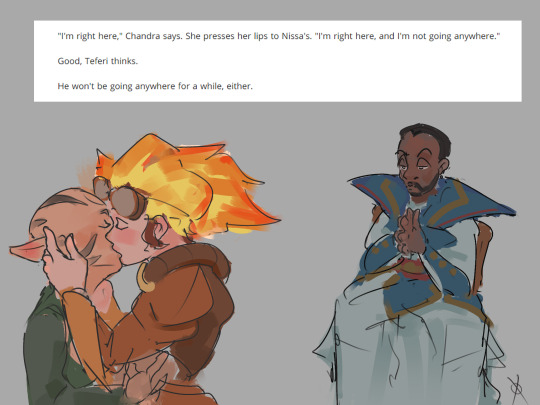
213 notes
·
View notes
Text





Chandra x Mango meme I made for @wielderofmysteries
150 notes
·
View notes
Text

"This new image of NGC 2264, also known as the 'Christmas Tree Cluster,' shows the shape of a cosmic tree with the glow of stellar lights. NGC 2264 is, in fact, a cluster of young stars — with ages between about one and five million years old — in our Milky Way about 2,500 light-years away from Earth. The stars in NGC 2264 are both smaller and larger than the Sun, ranging from some with less than a tenth the mass of the Sun to others containing about seven solar masses.
This new composite image enhances the resemblance to a Christmas tree through choices of color and rotation. The blue and white lights (which blink in the animated version of this image) are young stars that give off X-rays detected by NASA’s Chandra X-ray Observatory. Optical data from the National Science Foundation’s WIYN 0.9-meter telescope on Kitt Peak shows gas in the nebula in green, corresponding to the 'pine needles' of the tree, and infrared data from the Two Micron All Sky Survey shows foreground and background stars in white. This image has been rotated clockwise by about 160 degrees from the astronomer’s standard of North pointing upward, so that it appears like the top of the tree is toward the top of the image.

Young stars, like those in NGC 2264, are volatile and undergo strong flares in X-rays and other types of variations seen in different types of light. The coordinated, blinking variations shown in this animation, however, are artificial, to emphasize the locations of the stars seen in X-rays and highlight the similarity of this object to a Christmas tree. In reality the variations of the stars are not synchronized.
The variations observed by Chandra and other telescopes are caused by several different processes. Some of these are related to activity involving magnetic fields, including flares like those undergone by the Sun — but much more powerful — and hot spots and dark regions on the surfaces of the stars that go in and out of view as the stars rotate. There can also be changes in the thickness of gas obscuring the stars, and changes in the amount of material still falling onto the stars from disks of surrounding gas.
NASA’s Marshall Space Flight Center manages the Chandra program. The Smithsonian Astrophysical Observatory’s Chandra X-ray Center controls science operations from Cambridge, Massachusetts, and flight operations from Burlington, Massachusetts."
Date: December 19, 2023
NASA ID: link
#NGC 2264#Christmas Tree Cluster#Space#Galaxy#NASA#December#2023#gif#Chandra X-ray Observatory#X-ray Observatory#Chandra#Marshall Space Flight Center#MSFC#Huntsville#Alabama#my post
60 notes
·
View notes
Text
Why Do X-Ray Mirrors Look So Unusual?

Does the object in this image look like a mirror? Maybe not, but that’s exactly what it is! To be more precise, it’s a set of mirrors that will be used on an X-ray telescope. But why does it look nothing like the mirrors you’re familiar with? To answer that, let’s first take a step back. Let’s talk telescopes.
How does a telescope work?
The basic function of a telescope is to gather and focus light to amplify the light’s source. Astronomers have used telescopes for centuries, and there are a few different designs. Today, most telescopes use curved mirrors that magnify and focus light from distant objects onto your eye, a camera, or some other instrument. The mirrors can be made from a variety of materials, including glass or metal.
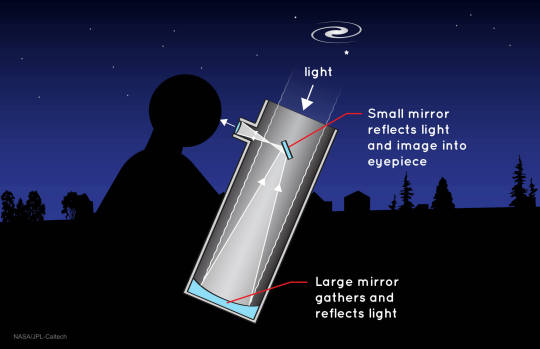
Space telescopes like the James Webb and Hubble Space Telescopes use large mirrors to focus light from some of the most distant objects in the sky. However, the mirrors must be tailored for the type and range of light the telescope is going to capture—and X-rays are especially hard to catch.
X-rays versus mirrors
X-rays tend to zip through most things. This is because X-rays have much smaller wavelengths than most other types of light. In fact, X-rays can be smaller than a single atom of almost every element. When an X-ray encounters some surfaces, it can pass right between the atoms!

Doctors use this property of X-rays to take pictures of what’s inside you. They use a beam of X-rays that mostly passes through skin and muscle but is largely blocked by denser materials, like bone. The shadow of what was blocked shows up on the film.
This tendency to pass through things includes most mirrors. If you shoot a beam of X-rays into a standard telescope, most of the light would go right through or be absorbed. The X-rays wouldn’t be focused by the mirror, and we wouldn’t be able to study them.

X-rays can bounce off a specially designed mirror, one turned on its side so that the incoming X-rays arrive almost parallel to the surface and glance off it. At this shallow angle, the space between atoms in the mirror's surface shrinks so much that X-rays can't sneak through. The light bounces off the mirror like a stone skipping on water. This type of mirror is called a grazing incidence mirror.
A metallic onion
Telescope mirrors curve so that all of the incoming light comes to the same place. Mirrors for most telescopes are based on the same 3D shape — a paraboloid. You might remember the parabola from your math classes as the cup-shaped curve. A paraboloid is a 3D version of that, spinning it around the axis, a little like the nose cone of a rocket. This turns out to be a great shape for focusing light at a point.

Mirrors for visible and infrared light and dishes for radio light use the “cup” portion of that paraboloid. For X-ray astronomy, we cut it a little differently to use the wall. Same shape, different piece. The mirrors for visible, infrared, ultraviolet, and radio telescopes look like a gently-curving cup. The X-ray mirror looks like a cylinder with very slightly angled walls.
The image below shows how different the mirrors look. On the left is one of the Chandra X-ray Observatory’s cylindrical mirrors. On the right you can see the gently curved round primary mirror for the Stratospheric Observatory for Infrared Astronomy telescope.

If we use just one grazing incidence mirror in an X-ray telescope, there would be a big hole, as shown above (left). We’d miss a lot of X-rays! Instead, our mirror makers fill in that cylinder with layers and layers of mirrors, like an onion. Then we can collect more of the X-rays that enter the telescope, giving us more light to study.

Nested mirrors like this have been used in many X-ray telescopes. Above is a close-up of the mirrors for an upcoming observatory called the X-ray Imaging and Spectroscopy Mission (XRISM, pronounced “crism”), which is a Japan Aerospace Exploration Agency (JAXA)-led international collaboration between JAXA, NASA, and the European Space Agency (ESA).
The XRISM mirror assembly uses thin, gold-coated mirrors to make them super reflective to X-rays. Each of the two assemblies has 1,624 of these layers packed in them. And each layer is so smooth that the roughest spots rise no more than one millionth of a millimeter.

Why go to all this trouble to collect this elusive light? X-rays are a great way to study the hottest and most energetic areas of the universe! For example, at the centers of certain galaxies, there are black holes that heat up gas, producing all kinds of light. The X-rays can show us light emitted by material just before it falls in.
Stay tuned to NASA Universe on Twitter and Facebook to keep up with the latest on XRISM and other X-ray observatories.
Make sure to follow us on Tumblr for your regular dose of space!
#NASA#spaceblr#astronomy#telescope#universe#astrophysics#XRISM#Chandra#x-ray vision#x-ray#space#technology#tech
1K notes
·
View notes
Text

if only my dog would look at me like she looks at a photographer holding treats
(sometimes she does)
📷 Allison Mae Photography
99 notes
·
View notes
Text
So whoever pulls the 001/001 "The One Ring" magic card is then obligated to travel to the nearest active Volcano and toss it into the fires of it right?

#magic the gathering#mtg#the one ring#lord of the rings#cards#cat cosplay#cosplay#cats#kitty#cats in costumes#cat#fan art#cat costume#cats of tumblr#aww#chandra#planeswalker
509 notes
·
View notes
Text








OC paintings so far! They are all based on something space related!
Left to Right:
James Webb (JWST), Trappist (TRAPPIST-1), Spitzer (SST), Chandra (CXO), Discovery (Space Shuttle), Habex (HabEx concept), Lynx (Lynx concept) and Luvoir (LUVOIR concept)
I have more ocs I plan to paint! Hubble and Origins are on the top of my list right now. Hope some of you might be interested to see them!
I also like talking about my ocs so if you want, you can ask me questions about them, or talk to me about anything space related because I love space!
#oc#original character#character design#character art#james webb#trappist#spitzer#chandra#space shuttle#discovery#habex#lynx#luvoir#my art#digital art#xenon art#space
80 notes
·
View notes
Text
the astrological implications of "lookalikes" and nakshatra characteristics - the dualistic nature of rahu and shani🪞

💎 in the seemingly constant conquest for people to find their dominant grahas within their birth chart, it is often helpful for people to compare their morphological features to that of celebrities who share their primary placements. many celebrities often dawn similar faces to their red carpet counterparts which is no coincidence. i have included a few of the ever-increasing physical similarities witnessed among celebrities below and commentaries on what contributes to their facial appearances. this should serve as subtle introduction to a morphology- and fashion-based series i hope to develop within the next year or so. as an additional thank you to the now 5,000 of you, i am also offering 20% off on my cosmetic cosmological readings and vedic reading bundle for the next week. thank you for all of your amazing support and i am beyond excited to witness the growth in people learning about vedic astrology and religion as a whole.

above lies a personal interpretation of mine on the grahas and how they relate to stylistic and morphological essence that i find will be helpful for understanding this post and more posts to come:

🪞 zoë saldana (left) and thandiwe newton (right)
saldana is mrigashira surya (tightly conjunct buddha), pushya lagna (tightly conjunct shukra), and anuradha chandra native. whereas, newton has a swati surya and swati (or vishakha) chandra. the only direct similarity between both women is both were born on monday (the day of the moon) and within their chandra mahadasha which can subtly increase their lunar inclinations.
while both celebrities do not have specific astrological rashis in common, there is a subtle nuance that lies within their astrological compatibility. saldana is extremely dominant in saturnian energies and newton is likely extremely dominant in rahuvian energies. shani and rahu natives are often mistaken for one another due to their similar properties. think of the two grahas as one combined coin of governance over the instances in which define material success in one's life (such as sorrow, pain, grit, and finances). shani acts as the grounded rahu, who is slowed and wise in his pursuit towards fulfillment. whereas, the out-of-body node rahu is exploitative, hasty, and rapid in movement. both govern over the trials and tribulations we may experience in our physicality. thus, both are intricately intertwined and so are their natives.
rahuvian natives share similar features of thinned and highly-arched eyebrows (characteristic of thinner eyebrows being considered more yin in nature), less prominent noses and chins, fuller cheeks, smaller facial frames, expertly defined cupid's bow, and large eyes. whereas, shani natives share similar (if not exact) features to that of rahu but with slightly less exaggerative features erring on the side of angelic essence (yin and ethereal, otherworldly, and mystical) compared to the ingenue essence likes of rahu (decorative, cute yin)

🪞 jaime pressly (left) and margot robbie (right)
another case study of rahuvian-saturnian beauty is pressly (pushya surya loosely conjunct shani and shravana chandra) and robbie (ardra surya tightly conjunct brihaspati, punarvasu lagna tightly conjunct buddha, and swati chandra), both of which share a shani atmakaraka (the graha/karaka most indicative of oneself). both celebrities share the similar characteristics of the two grahas which highly emphasize yin-nature. the subtle essences of both graha types are analyzed below. both of which favor yin and small facial features and clothing details (such as dainty jewelry pieces, note how many of the graha natives sport blue jewelry indicative of shani's rulership) and lighter and softer features (such as bleached/highlighted hair and naturalistic, nude coloring in makeup):
rahu aesthetics: yin, but decorative small-scale yin. features flowing, rounded shapes in both anatomy and clothing-styles. small, compact figure in which natives prefer to adorn themselves with small decorations and details, such as delicate trimmings.
shani aesthetics: most yin essence of the grahas (though it flows back into yang). it is a type of yin that is ethereal in nature. natives' body type has the least concrete shape of all the essences. its silhouettes are long and flowing with draping and webbing. fine textures, as well as transparent and iridescent colours, contribute to their ethereal appearance.

🪞 sarah hyland (left) and mila kunis (right)
hyland has a swati lagna, anuradha surya tightly conjunct shukra, and dhanishta chandra loosely conjunct rahu. kunis has an ashlesha surya, anuradha lagna loosely conjunct ketu and brihaspati, and swati chandra loosely conjunct shani. despite both women being influenced by different planetary aspects (including the oppositionary ketu for kunis), you can notice yet again their saturnian (specifically anuradha) and rahuvian (specifically swati) aspects dominating both women almost entirely.
anuradha: as i spoke about in a previous post on this nakshatra, anuradha natives possess specific, bunny-like features indicative of the nakshatra's rabbit yoni. these natives often possess big, round, and bright eyes; rounded foreheads; full yet smaller horizontal surface area lips; and prominent central incisors.
swati: swati's dominance over mahamaya results in natives' face types having the same length and width dimensions. it is harmonious as a whole without any dominative unique features. they are genetically predisposed to a beautifully attractive round face with harmonic and regular proportions specifically surrounding the contour region of their face. due to the mahamaya emphasis, natives of swati have a distinct affinity for facial feminizing techniques (such as hairline modifications, jaw reduction, rhinoplasty (nose reduction), and facial lifts). note that these improvements might appear the best on these natives due to their rahuvian abundance, but natives must learn to balance this affinity for bodily modification (specifically with their nose or cheekbones) with equal bouts of self care and physical reflection.

🪞 nina dobrev (left) and victoria justice (right)
nina dobrev has an jyeshta lagna, purva ashadha surya loosely conjunct shani, and shravana chandra tightly conjunct buddha. victoria justice has a dhanishta surya, shravana chandra loosely conjunct shani, and swati lagna. both celebrities share similar venusian and saturnian undertones, yet it is likely the shravana emphasis that further adds identical qualities to both women. shravana beauty, contrarily to pushya, it is chandra-based beauty (sensual, deep yin) with saturnian undertones (ethereal yin).
chandra (a graha with emphasis on femininity)-based beauty is mature and sensual when in conjunction with shani (a graha with emphasis on traditionalized values). overall resulting in a romantic-essence beauty type: like the circular shape of a voluptuous, full moon, the romantic shravana silhouette is curvy and round, mirroring that of an hourglass. soft, flowing garments create movement in the silhouette, whereas romantic colors (that of a red and pink palette) look best on these women.
consequently, individuals with the shravana style essence tend to create an overall visual impression of sensuality and glamor. although their essence is yin, such as the ingenue, rahuvian essence, it is a mature sensuality as opposed to the cute, innocent prettiness of rahuvian natives. adjectives such as sexy, 'womanly', and glamorous can be used to describe these natives. abstractly, one can associate the shravana style/anatomical essence with the themes of luxury and indulgence. this aura specifically conjures up images of expensive jewellery, candlelit dinners, and red roses similar to the blooming nature of this nakshatra's artha purushartha and brahma trimurthi.

🪞lili reinhart (left) and brittany murphy (right)
reinhart has an uttara phalguni surya and chandra (loosely conjunct rahu) and swati lagna. whereas, murphy has an ashlesha lagna and swati surya and chandra (loosely conjunct shukra). both women share a surya atmakaraka and brihaspati amatyakaraka. yet again we see a physical example of rahu being indicative of identical similarity amongst others. this is likely due to rahu and shani (if aspecting one's surya or chandra) in one's natal chart being indicative of twins. specifically these aspects include the seventh house and bahuputra yoga. the two grahas' indication of twins can manifest one finding other non-related individuals who share an eerily similar appearance or siblings who are specifically dominant in shani and/or rahu energies looking identical despite not being identical twins. both individuals serving as seperate sides of the same cosmological coin.
also note the stylistic differences between reinhart and murphy above. murphy looks more natural in the shani-based vata colors of silvers and blues. whereas, reinhart looks absolutely gorgeous yet slightly "off" in the neon-red coloring of her dress (due to the countering pitta dosha nature of red). while reinhart may be influenced by the pitta surya via her surya and chandra, it is clear she favors vata coloring naturally. do note that vata dosha colors such as brown and grey should be avoided for those experiencing common vata-associated issues with matters such as anxiety and depression. this is why it is recommended for these natives to incorporate soft, pastel, and pale iterations of the respective colors, such as red or orange. too bright or cold colors can bring natives of this dosha more out of balance. however, white is said to have a good effect on people with a predominant vata dosha constitution. additionally, the accumulated surplus of vata dosha is well influenced by the color yellow (likely contributing to rahu and shani's favoring of blonde hair and highlights).

🪞keira knightley (left) and natalie portman (right)
knightley has an uttara bhadrapada surya (loosely conjunct buddha and shukra) and rohini chandra. portman has a rohini surya, swati lagna, and purva phalguni chandra. both were born on tuesday (the day of shani). both women incorporate lunar romanticism but differ with their shani and rahu influences ever so slightly.
shani subtlety: a combination of of ying features and mysticism, also known as the ethereal and most yin essence. consequently, individuals with the subtlety of shani tend to create an overall visual impression of softness and otherworldliness or mysticism. although they are more feminine like the rahu and lunar essences, this is an 'old soul' kind of femininity as opposed to sensual or cute, pretty femininity. adjectives such as mysterious, ethereal, mystical, or 'old soul' can be used to describe people under this graha's influence. abstractly, one can associate the graha with the themes of mysticism and the cosmos, often conjuring up images of mythical creatures, fairies and mermaids, and the cosmos and galaxies within others.
rahu subtlety: a combination of femininity with childlike innocence and delicacy, also known as the decorative, small-scale yin subtlety. consequently, individuals with rahu subtlety tend to create an overall visual impression of youthful femininity and innocence. although this subtlety is feminine like the lunar essence, it is a childlike, innocent cuteness as opposed to the mature, sensual femininity of the lunar individual. adjectives like gentle, cute, and pretty could be used to describe natives. abstractly, one can associate rahu subtlety with the themes of innocence and youthful idealism, conjuring up images of delicate flowers.
note both natives have a rectangular-shaped face with square foreheads and jawlines. they have long, ovular faces but with angular edges. they both possess immense symmetry and harmony as seen in lunar women but their vata influences dominate this abundance with facial contouring and structural emphasis. their overall appearance is an example of vata extremism with lunar subtleties. compared to more vata-lunar natives like dobrev and justice, one can really see their morphological differences. additionally, these aforementioned planetary subtleties are also witnessed with both of the actresses careers. for example, knightley stars in more whimsical or vintage films such as "pride and prejudice", "the duchess", and "pirates of the caribbean". whereas, portman stars in more romantic, subtle thrillers that embody the purity complex seen within rahu, such as "black swan", "v for vendetta", and "leon".

🪞 zooey deschanel (left): uttara ashadha surya, chandra, and lagna (tightly conjunct buddha) born on thursday, day of brihaspati, with chandra amatyakaraka
🪞katy perry (right): swati surya and lagna (tightly conjunct buddha) and vishakha chandra (tightly conjunct shani) born on thursday, day of brihaspati, with chandra amatyakaraka
🪐 are you saturn and/or rahu dominant? have you encountered similar instances of being compared to other people or celebrities based on your physical appearance? i think it is interesting that even individuals influenced by these grahas are compared to other people more so than those who are not influenced by shani or rahu. it is likely people would suspect buddha to be involved in this phenomena. however, buddha is not implicative of identical nature, it is implicative of the flattery that lies within mimicry via emulation. this is why mercurial celebrities often undergo bodily alterations to resemble rahuvian/saturnian celebrities (such as bella hadid's cosmetic transformation into resembling carla bruni or the character elvira's direct copying of the character vampira).

🪞 jessica chastain (left) and bryce dallas howard (right)
additional examples of astrological lookalikes:
jessica chastain (anuradha lagna, rohini chandra loosely conjunct brihaspati, and uttara bhadrapada surya loosely conjunct buddha) and bryce dallas howard (revati lagna, shatabhisha surya loosely conjunct kuja and shukra, and uttara ashadha chandra). both share chandra atmakarakas.
jordin sparks (swati chandra, mula surya loosely conjunct shani, and purva ashadha lagna) and america ferrera (ashwini surya tightly conjunct buddha, anuradha chandra tightly conjunct kuja, and purva ashadha lagna tightly conjunct brihaspati)
kiernan shipka (vishakha surya and anuradha chandra) and emma watson (ashwini surya, uttara phalguni lagna, and mula chandra)
* all of these placements were found using astrotheme/.com and/or astro-charts/.com. it is important to note that some chandra (moon) placements may be off by up to 6 degrees and lagnas (ascendants/rising signs) as well, due to the fact that many websites do not have 100% accurate birth times for the given celebrities.
xoxo, angel 💋 (will be uploading part two of my buddha self care exploration soon lovelies)
#vedicastrology#astrology#nakshatras#moon#rahu ketu#mercury planet#budha#saturn#chandra#buddha#twins#identical
391 notes
·
View notes